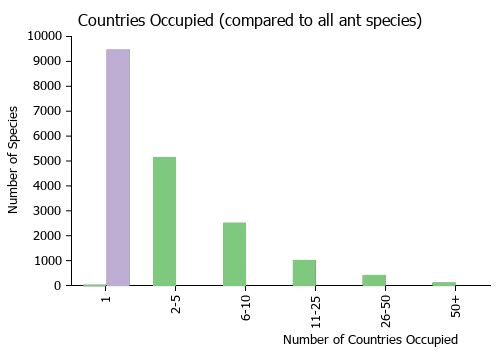Strumigenys xenognatha
| Strumigenys xenognatha | |
|---|---|
| Scientific classification | |
| Kingdom: | Animalia |
| Phylum: | Arthropoda |
| Class: | Insecta |
| Order: | Hymenoptera |
| Family: | Formicidae |
| Subfamily: | Myrmicinae |
| Tribe: | Attini |
| Genus: | Strumigenys |
| Species: | S. xenognatha |
| Binomial name | |
| Strumigenys xenognatha Kempf, 1958 | |
Bolton (2000) - The single specimen of this species was found together with workers that comprise the type-series of Strumigenys laevipleura. All the ants were taken from an orchid in U.S. quarantine. Kempf (1958a) speculated on the circumstances of this. He noted that the differences between the queen and its apparently associated workers were greater than in any other known species of the group, and suggested that the series may have been mixed or that the queen was a social parasite. Whatever, he decided that the queen merited description as a separate taxon but admitted that it could represent the genuine queen of laevipleura. I can do nothing to resolve the problem as no further material of either has been discovered, and so retain xenognatha as a species.
Identification
A member of the gundlachi-complex in the Strumigenys gundlachi group.
Keys including this Species
Distribution
Latitudinal Distribution Pattern
Latitudinal Range: 6.235° to 6.235°.
| North Temperate |
North Subtropical |
Tropical | South Subtropical |
South Temperate |
- Source: AntMaps
Distribution based on Regional Taxon Lists
Neotropical Region: Colombia (type locality).
Distribution based on AntMaps
Distribution based on AntWeb specimens
Check data from AntWeb
Countries Occupied
| Number of countries occupied by this species based on AntWiki Regional Taxon Lists. In general, fewer countries occupied indicates a narrower range, while more countries indicates a more widespread species. |

|
Estimated Abundance
| Relative abundance based on number of AntMaps records per species (this species within the purple bar). Fewer records (to the left) indicates a less abundant/encountered species while more records (to the right) indicates more abundant/encountered species. |

|
Biology
Castes
Nomenclature
The following information is derived from Barry Bolton's Online Catalogue of the Ants of the World.
- xenognatha. Strumigenys xenognatha Kempf, 1958b: 64, fig. 4 (q.) COLOMBIA. Combination in Pyramica: Bolton, 1999: 1673; in Strumigenys: Baroni Urbani & De Andrade, 2007: 130. See also: Bolton, 2000: 196.
Unless otherwise noted the text for the remainder of this section is reported from the publication that includes the original description.
Description
Queen
Bolton (2000) - TL 3.25, HL 0.65, HW 0.51, CI 79, ML 0.41, MI 63, AL 0.84 (measurements from Kempf, 1958a). As Strumigenys laevipleura but differing as follows.
1 Mandibles relatively longer, MI 63 (as opposed to MI 56-57 in laevipleura).
2 Inner margin of mandible concave in vicinity of preapical teeth but markedly convex distally.
3 Preapical dentition restricted to 2 denticles, in the apical third of the length, the proximal denticle longer and stouter than the distal.
4 Scape almost linear, lacking a noticable subbasal bend.
In addition, the specialised projecting hairs are stiff and simple, those at the humeri long. Hairs on the first gastral tergite are simple, stiff and quite numerous, short straight and bristly. Basigastral costulae are faint and extremely short; only 4 - 5 can be discerned and they are shorter than the thickness of the pospetiolar spongiform collar.
Type Material
Holotype queen, COLOMBIA: Medellin Col., 3-22-46, SF 20456 Sup, 46-4823 (U. S. Plant Quarantine interception, San Francisco, California, 22.iii.1946, on orchid Miltonia sp.) (National Museum of Natural History) (examined).
References
- Baroni Urbani, C. & De Andrade, M.L. 2007. The ant tribe Dacetini: limits and constituent genera, with descriptions of new species. Annali del Museo Civico di Storia Naturale “G. Doria” 99: 1-191.
- Bolton, B. 1999. Ant genera of the tribe Dacetonini (Hymenoptera: Formicidae). J. Nat. Hist. 3 33: 1639-1689 (page 1673, Combination in Pyramica)
- Bolton, B. 2000. The ant tribe Dacetini. Mem. Am. Entomol. Inst. 65: 1-1028 (page 196, redescription of worker)
- Brown, W. L., Jr. 1962c. The neotropical species of the ant genus Strumigenys Fr. Smith: synopsis and keys to the species. Psyche. 69:238-267.
- Kempf, W. W. 1958b. Three new ants of the genus Strumigenys from Colombia (Hym. Formicidae). Rev. Bras. Entomol. 8: 59-68 (page 64, fig. 4 queen described)
- [[Media:Silva, T.S.R.D., Chaul, J.C.M. et al. 2022. Lectotype designation and redescription of four commonly collected Neotropical species of Strumigenys (10.5852@ejt.2022.798.1673).pdf|Silva, T.S.R.D., Chaul, J.C.M., Feitosa, R.M. 2022. Lectotype designation and redescription of four commonly collected Neotropical species of Strumigenys (Hymenoptera: Formicidae). European Journal of Taxonomy, 798(1), 103–126 (Template:Doi.org).]]
References based on Global Ant Biodiversity Informatics
- Bolton, B. 2000. The Ant Tribe Dacetini. Memoirs of the American Entomological Institute 65
- Kempf, W.W. 1972. Catalago abreviado das formigas da regiao Neotropical (Hym. Formicidae) Studia Entomologica 15(1-4).